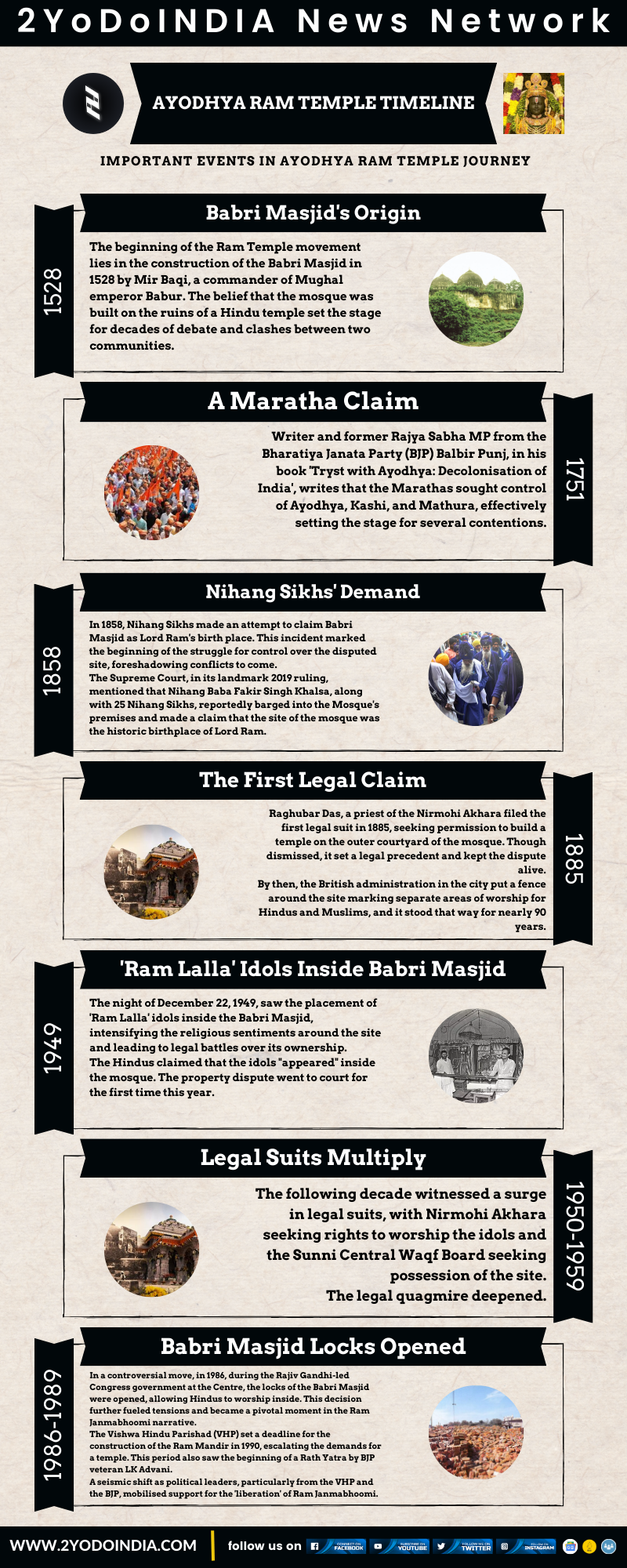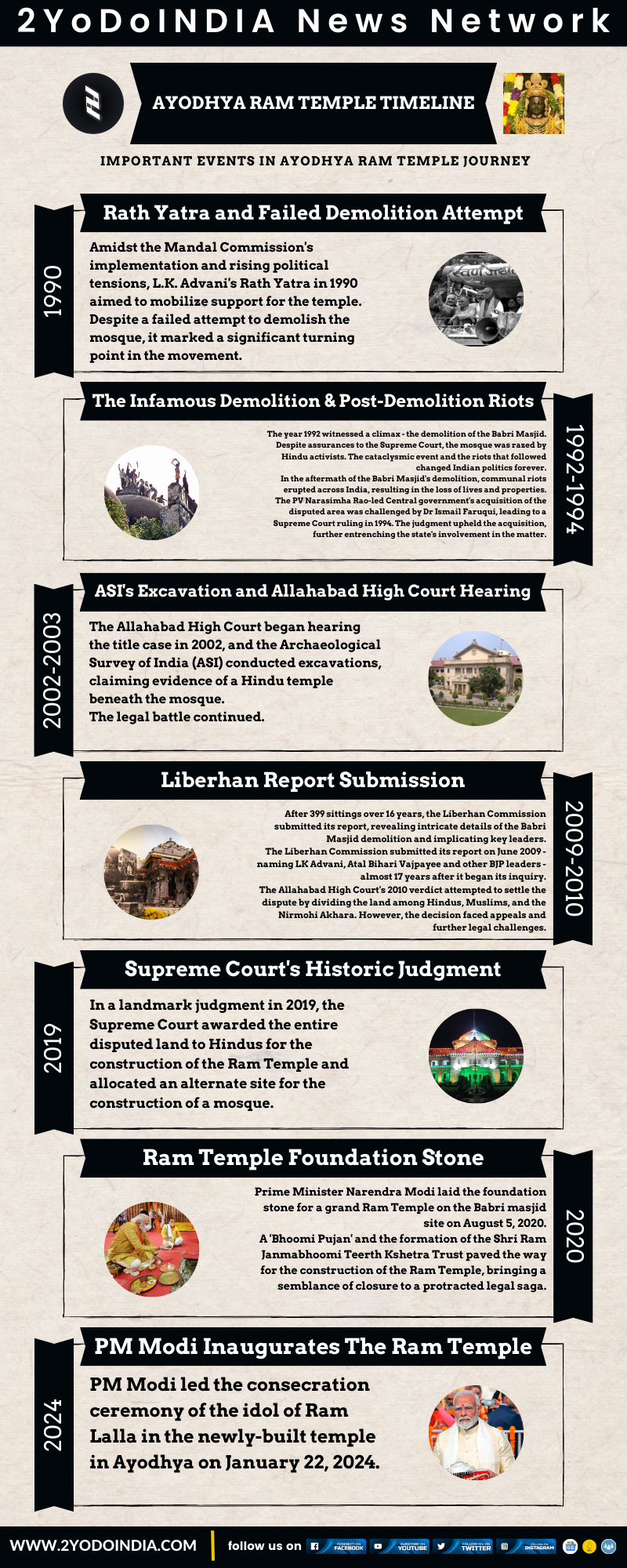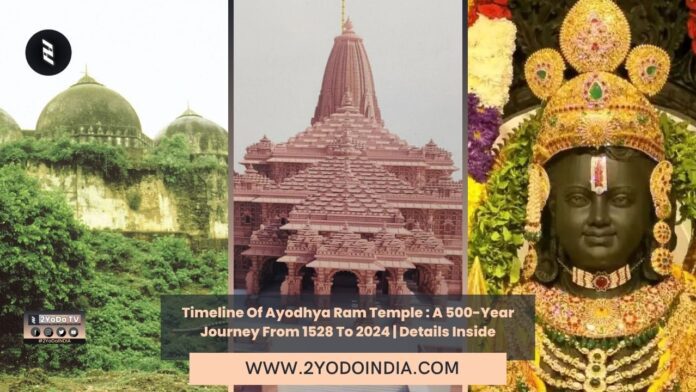About 400 pillars, 44 doors, and a new idol of Lord Ram, the grand temple in Ayodhya was officially inaugurated by Prime Minister Narendra Modi on 22nd January 2024, with hundreds of religious figures, politicians and Bollywood celebrities in attendance.
As we witnesses the ceremony in the ancient city, now look back at how a 500-year dispute culminated in the construction of the Ram Temple in Ayodhya.
1528
A mosque was built on the site by Mughal emperor Babar which Hindus allege to be the birth place of Lord Ram and where a temple earlier existed.
1529
Babri Mosque construct by Mir Baqi.
1530-1605
There were multiple allegations of conflicts and incidents of sectarian violence in relation to the Mandir-Masjid debate.
During the time of Akbar, a platform was constructed in front of the mosques.
As per reports, a royal order was pass stating that Hindus shouldn’t be stop from performing puja at the platform.
1885
Mahant Raghubir Das files the first suit in the matter, seeking to build a temple on land adjoining the mosque.
The Faizabad District Magistrate (DM) refuses him permission.
Then, Mahant Raghubir Das files a title suit in Faizabad Court against the Secretary of State for India, seeking permission to build a temple on the chabutra (courtyard) of the Babri mosque.
Faizabad Court rejects his plea.
1859
British officials erect a fence to separate the places of worships, allowing the inner court to be used by Muslims and the outer court by Hindus.
1949
On the night of 22nd December 1949, a Ram Idol appears inside the mosque.
Hindus see the appearance of the Idol as a divine revelation, but many argue that the Idol was smuggle inside at night.
Hindus start offering prayers.
The Government declares the site a “contested area” and locks the entrance.
1950
Two suits are file in Faizabad Court by Gopal Singh Viharad and Paramhansa Ramachandra Das, seeking permission to conduct Hindu pujas to Ram Lalla.
The Court grant the parties permission to conduct pujas.
The Court orders the inner courtyard gates to remain locked.
1959
Nirmohi Akhara files a third suit, seeking possession of the land.
Nirmohi Akhara enter the fray and files the third suit, seeking possession of the site, doing away with the court-appointed receiver.
It claim itself to be the custodian of the spot at which Ram was supposedly born.
1961
UP Sunni Wakf Board files a suit seeking possession of Babri Mosque site.
They also demand the removal of Ram Idols from Babri Masjid.
1983
The Vishwa Hindu Parishad (VHP) start nationwide movement for construction of temple at the disputed site in Ayodhya.
1984
Vishwa Hindu Parishad (VHP) constitutes a group to start the Ram Janmbhoomi Movement.
BJP leader LK Advani is made the leader of the campaign.
1986
A third party, lawyer UC Pandey appeals for the gates to be unlock before the Faizabad Session Court, on the grounds that the Faizabad district administration, and not a Court, had ordered its closure.
District Judge orders the locks to be removed to allow Hindu “pooja and darshan”.
Muslims constitute a Babri Mosque Action Committee (BMAC) in protest.
1989
A fresh suit was file by former VHP vice-president Deoki Nandan Agarwala in the name of Lord Ram for declaration of the title and possession in its favour at the Lucknow bench of the Allahabad high court.
PM Rajiv Gandhi allows the VHP to perform Shilanayas (laying of foundation stone) near the disputed area.
Another suit in name of Ram Lalla Virajman was file in the High Court, naming the parties in the Nirmohi Akhara (1959) and Sunni Waqf Board (1961) suits as defendants.
VP Singh becomes Prime Minister of the country and Janata Dal-led National Front government comes to power.
1990
VHP volunteers partially damage the mosque. Prime Minister Chandra Shekhar tries to resolve the dispute through negotiations, which fail the next year.
LK Advani launches a Rath Yatra from Somnath (Gujarat) to Ayodhya (UP) to incite support for the Movement.
Communal riots break out.
Karsevaks under VHP leaders clash with Uttar Pradesh police in Ayodhya, police uses force to control the crowd.
Scores of karsevaks are killed.
1991
BJP became the biggest opposition party in Lok Sabha after general elections with 120 seats.
BJP came to power in Uttar Pradesh, Kalyan Singh becomes Chief Minister
1992
Babri Mosque raze by a violent mob of Karsevaks.
The Karsevaks leave behind a make-shift temple in its place.
10 days after the Mosque was demolish, the PM forms a committee led by retired High Court Justice M. S. Liberhan, to look into circumstances leading to the demolition of the Babri Mosque and the communal riots.
The Commission was originally mandate to submit its report within three months of its formation.
Timeline of Ayodhya Ram Temple: Tracing the Roots – A Historical Chronicle from 1528 to 2024
— 2YoDoINDIA News Network (@2yodoindia) January 23, 2024
For Full Details visit : https://t.co/BIGAPOBiOr#2YoDoINDIA #RamMandir #Ram #Ayodhya #JaiShriRam #AyodhyaRamTemple #HistoricalJourney #FaithInStone #LegacyOfDevotion pic.twitter.com/nwBlmsM62D
1993
Narsimha Rao Government issues an ordinance acquiring 67.7 acres of land (Site and adjoining areas).
Then it was pass as a law, Acquisition of Certain Areas at Ayodhya Act, 1993 to facilitate the acquisition of land by the Central government.
1994
The SC by a majority of 3:2 upheld the constitutionality of Acquisition of Certain Areas at Ayodhya Act.
The majority judgment by former CJI J.S. Verma reason that every religious immovable property is liable to be acquired.
The SC adjudge that offering namaz at mosque was not integral to Islam unless that mosque had any particular significance in Islam.
The judgment has been criticize for regarding the mosque as a non-essential place of worship.
There were no reviews file against Ismail Faruqui.
1996
BJP became single largest party in Lok Sabha elections, Atal Bihari Vajpayee became PM for 13 days.
1998
BJP return to power with Atal Bihari Vajpayee as PM for second time.
The government last 13 months.
1999
BJP again comes to power at the Centre with a coalition of National Democratic Alliance (NDA) and completes full term.
2001
Tensions rise on the anniversary of the demolition of the mosque.
VHP pledges again to build Hindu temple at the site.
2002
Atal Bihari Vajpayee had set up an Ayodhya cell in his office and appoints a senior official, Shatrughna Singh, to hold talks with Hindu and Muslim leaders.
BJP rule out committing itself to the construction of a temple in its election manifesto for UP assembly elections.
VHP confirm deadline of 15 March to begin construction.
Hundreds of volunteers converged on the site.
While, in a supposedly related incident at least 58 people were kill in an attack on a train in Godhra which was carrying Hindu activists returning from Ayodhya.
Following the train attack, some 2,000 people die in riots in Gujarat.
Three Allahabad High Court judges began hearings on determining who owns the religious site.
The Lucknow Bench of the Allahabad High Court begins hearing Ayodhya Title Dispute.
2003
Archaeological Survey of India begins excavating the land underneath the dispute site under the directions of the Allahabad High Court.
The ASI survey said that there was evidence of a temple beneath the mosque, but Muslims disputed the findings.
Atal Bihari Vajpayee said at the funeral of Hindu activist Ramchandra Das Paramhans that he would fulfil the dying man’s wishes and build a temple at Ayodhya.
But, he hope the courts and negotiations will solve the issue.
It also claims to have found remnants of a 10th century Hindu Temple.
A court rule that seven Hindu leaders should stand trial for inciting the destruction of the Babri Mosque, but no charges were brought against Advani, then deputy prime minister, who was also at the site in 1992.
Muslims question the ASI report.
2004
UP rule that an earlier order which exonerated LK Advani for his role in the destruction of the mosque should be review.
2005
Suspect Islamic militants attack the dispute site, using a jeep laden with explosives to blow a hole in the wall of the complex.
Security forces kill five people they said were militants, and a sixth who was not immediately identified.
2009
After a delay of 17 years, the Librehan Commission submits its report to the Prime Minister, though its contents are not made public.
2010
The High Court delivers its judgment, dividing the land between three parties: one third for the Sunni Wakf Board, one third for the Nirmohi Akhara and one third to Ram Lalla Virajman.
The Judgment of the Lucknow Bench of the High Court on 30th September, 2010, divide the dispute land in Ayodhya in 2:1 ratio among the Muslim and Hindu litigants.
High Court allot the dome of the demolish Babri Masjid, under which the makeshift temple currently stands, to the Hindus.
The structure was demolish by a group of Karsevaks on 6th December, 1992.
The nearby Ram Chabutra and Sita Rasoi also went to the Nirmohi Akhara.
The one-third share of the Sunni Wakf Board comprises the outer courtyard of the disputed land.
2011
The Supreme Court admits a batch of petitions filed by all parties.
A Division Bench of Aftam Alam and R.M. Lodha JJ term the High Court Judgment as “strange”. RM Lodha observes “a new dimension has been given by the High Court as the decree of partition was not sought by the parties.
2015
VHP launch a campaign in Rajasthan to gather Shilas.
After more than ten years, two truckloads of etched stones arrived in Ayodhya.
The state’s SP government declare the Shilas would not be allow admission into Ayodhya.
2017
Former Chief Justice Khehar suggests an out of court settlement among all parties.
The 3 judge bench of SC comprising Dipak Misra CJI, Ashok Bhushan and Abdul Nazeer JJ began hearing the appeal.
2018
The petitioners argue that the SC ought to refer the 1994 Ismail Faruqui judgment to a 7-judge Bench for reconsideration.
The SC reserves judgment on the question of referring the appeal to a larger Bench
The 3 judge bench in a split of 2:1 verdict held that the Ismail Faruqui judgment of 1994 does not require reconsideration by a larger bench.
2019
SC constituted a mediation panel with FM Kalifulla as the chairman and comprising spiritual leader Sri Sri Ravi Shankar and senior advocate Sriram Panchu, to mediate in the land title dispute.
SC announce that on basis of the report submitted by the Chairman of the committee, the mediation failed.
The court order day-to-day hearing of the case from 6 August.
A five-judge constitution bench headed by Chief Justice Ranjan Gogoi, and comprising Justices Sharad Arvind Bopde, Dhananjaya Yeshwant Chandrachud, Ashok Bhushan and Abdul Nazeer began day-to-day hearing of the case.
The almost 70-year long dispute came to an end.
The five-judge bench order setting up of a trust that paved the way for construction of a temple at Ayodhya.
It also order allotting 5 acres to Muslims in Ayodhya for building a mosque.
2020
PM Narendra Modi announce in Lok Sabha the formation of a trust to construct a Ram temple in Ayodhya.
Prime Minister Narendra Modi laid the foundation stone for a grand Ram Temple on the Babri masjid site on 5th August, 2020.
A ‘Bhoomi Pujan’ and the formation of the Shri Ram Janmabhoomi Teerth Kshetra Trust paved the way for the construction of the Ram Temple, bringing a semblance of closure to a protracted legal saga.
2024
PM Modi led the consecration ceremony of the idol of Ram Lalla in the newly-built temple in Ayodhya on 22nd January, 2024.
The new Ram Lalla idol was consecrated at the Ayodhya temple, an event watched by lakhs of people on television at their homes and in temples across the country.
PM Modi took part in the ‘pran pratishtha’ rituals in the presence of Uttar Pradesh Governor Anandiben Patel, Uttar Pradesh Chief Minister Yogi Adityanath and RSS chief Mohan Bhagwat.
Watch Full Event of 22nd January 2024
Main Events of Ayodhya Ram Temple







